
OST-Arbeiter
Encyclopedia
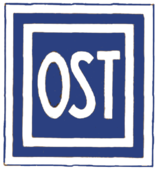
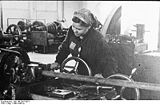
Eastern Europe
Eastern Europe is the eastern part of Europe. The term has widely disparate geopolitical, geographical, cultural and socioeconomic readings, which makes it highly context-dependent and even volatile, and there are "almost as many definitions of Eastern Europe as there are scholars of the region"...
to do forced labor in Germany during World War II
Forced labor in Germany during World War II
The use of forced labour in Nazi Germany and throughout German-occupied Europe during World War II took place on an unprecedented scale. It was a vital part of the German economic exploitation of conquered territories. It also contributed to the mass extermination of populations in German-occupied...
. The Ostarbeiters were mostly from the territory of Reichskommissariat Ukraine
Reichskommissariat Ukraine
Reichskommissariat Ukraine , literally "Reich Commissariat of Ukraine", was the civilian occupation regime of much of German-occupied Ukraine during World War II. Between September 1941 and March 1944, the Reichskommissariat was administered by Reichskommissar Erich Koch as a colony...
(eastern Ukraine
Ukraine
Ukraine is a country in Eastern Europe. It has an area of 603,628 km², making it the second largest contiguous country on the European continent, after Russia...
). Ukrainians
Ukrainians
Ukrainians are an East Slavic ethnic group native to Ukraine, which is the sixth-largest nation in Europe. The Constitution of Ukraine applies the term 'Ukrainians' to all its citizens...
made up the largest portion although many Belarusians
Belarusians
Belarusians ; are an East Slavic ethnic group who populate the majority of the Republic of Belarus. Introduced to the world as a new state in the early 1990s, the Republic of Belarus brought with it the notion of a re-emerging Belarusian ethnicity, drawn upon the lines of the Old Belarusian...
, Russians
Russians
The Russian people are an East Slavic ethnic group native to Russia, speaking the Russian language and primarily living in Russia and neighboring countries....
, Poles
Poles
thumb|right|180px|The state flag of [[Poland]] as used by Polish government and diplomatic authoritiesThe Polish people, or Poles , are a nation indigenous to Poland. They are united by the Polish language, which belongs to the historical Lechitic subgroup of West Slavic languages of Central Europe...
and Tatars
Tatars
Tatars are a Turkic speaking ethnic group , numbering roughly 7 million.The majority of Tatars live in the Russian Federation, with a population of around 5.5 million, about 2 million of which in the republic of Tatarstan.Significant minority populations are found in Uzbekistan, Kazakhstan,...
were also present. Estimates put the number of OST-Arbeiters between 3 million and 5.5 million. Some estimates place the number as high as 8.5 million workers.
Most were very young, under the age of 16, as those older than 16 were usually conscripted. 30% were as young as 12–14 years of age when they were taken to Germany
Nazi Germany
Nazi Germany , also known as the Third Reich , but officially called German Reich from 1933 to 1943 and Greater German Reich from 26 June 1943 onward, is the name commonly used to refer to the state of Germany from 1933 to 1945, when it was a totalitarian dictatorship ruled by...
. By November 1943 the age limit was dropped to 10. 50% of those taken from Ukraine were girls and women.
OST-Arbeiters from Reichskommissariat Ukraine were forced to wear a dark blue and white badge with "OST", the German word for East.
Terminology
The official German records for the late summer of 1944 listed 7.6 million foreign civilian workers and prisoners of war in the territory of the "Greater German Reich", who for the most part had been brought there for employment by force. Thus, they represent roughly a quarter of all registered workers in the entire economy of the German Reich at that time.A class system was created amongst the "Fremdarbeiter" [foreign workers] brought to Germany
Germany
Germany , officially the Federal Republic of Germany , is a federal parliamentary republic in Europe. The country consists of 16 states while the capital and largest city is Berlin. Germany covers an area of 357,021 km2 and has a largely temperate seasonal climate...
to work for the Third Reich. The multi-layered system was based on layers of national hierarchies.
- Gastarbeitnehmer
- guest workers
- Germanic, ScandinavianScandinaviaScandinavia is a cultural, historical and ethno-linguistic region in northern Europe that includes the three kingdoms of Denmark, Norway and Sweden, characterized by their common ethno-cultural heritage and language. Modern Norway and Sweden proper are situated on the Scandinavian Peninsula,...
and ItalianItalyItaly , officially the Italian Republic languages]] under the European Charter for Regional or Minority Languages. In each of these, Italy's official name is as follows:;;;;;;;;), is a unitary parliamentary republic in South-Central Europe. To the north it borders France, Switzerland, Austria and...
workers.
- Germanic, Scandinavian
- guest workers
- Zwangsarbeiter
- forced workers
- Militärinternierte
- military internees
- Primarily POWs
- military internees
- Zivilarbeiter
- civilian workers
- Primarily Polish prisoners from the General GovernmentGeneral GovernmentThe General Government was an area of Second Republic of Poland under Nazi German rule during World War II; designated as a separate region of the Third Reich between 1939–1945...
- They received lower wages and food rations; had to work longer hours than Germans; could not use public conveniences (from public transport to restaurants or churches); possessions of certain items was forbidden; and were required to wear a sign - the "Polish-P" - attached to their clothing.
- Primarily Polish prisoners from the General Government
- civilian workers
- Ostarbeiter
- Eastern workers
- Eastern worker were primarily from "Reichskommissariat UkraineReichskommissariat UkraineReichskommissariat Ukraine , literally "Reich Commissariat of Ukraine", was the civilian occupation regime of much of German-occupied Ukraine during World War II. Between September 1941 and March 1944, the Reichskommissariat was administered by Reichskommissar Erich Koch as a colony...
". They were marked with a sign OST ("East") and were subject to even harsher conditions than the civilian workers. They were forced to live in special camps that were fenced with barbed wire and under guard, and were particularly exposed to the arbitrariness of the Gestapo and the commercial industrial plant guards. At the end of the war 5.5 million Ostarbeiters were returned to the USSR.
- Eastern worker were primarily from "Reichskommissariat Ukraine
- Eastern workers
History
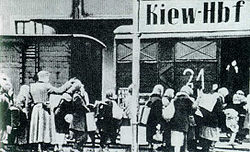
Preamble
Nazi GermanyNazi Germany
Nazi Germany , also known as the Third Reich , but officially called German Reich from 1933 to 1943 and Greater German Reich from 26 June 1943 onward, is the name commonly used to refer to the state of Germany from 1933 to 1945, when it was a totalitarian dictatorship ruled by...
faced a crisis at the end of 1941 because after it had mobilized its massive armies, a shortage of workers developed in Germany to support the war industry. Hermann Göring
Hermann Göring
Hermann Wilhelm Göring, was a German politician, military leader, and a leading member of the Nazi Party. He was a veteran of World War I as an ace fighter pilot, and a recipient of the coveted Pour le Mérite, also known as "The Blue Max"...
initially thought "the best thing would be to kill all men in Ukraine over fifteen years of age" but then realized working them to death was more beneficial for the Third Reich. To help overcome this shortage of labour Göring decided to bring in people from the recently seized territories of eastern Europe
Eastern Europe
Eastern Europe is the eastern part of Europe. The term has widely disparate geopolitical, geographical, cultural and socioeconomic readings, which makes it highly context-dependent and even volatile, and there are "almost as many definitions of Eastern Europe as there are scholars of the region"...
, primarily Ukraine
Ukraine
Ukraine is a country in Eastern Europe. It has an area of 603,628 km², making it the second largest contiguous country on the European continent, after Russia...
, to work in German war industries. These workers from "Reichskommisariat Ukraine" were called Ostarbeiters (east workers).
Voluntary recruitment
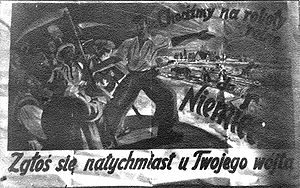
Fritz Sauckel
Ernst Friedrich Christoph "Fritz" Sauckel was a Nazi war criminal, who organized the systematic enslavement of millions from lands occupied by Nazi Germany...
for workers to go to Germany. "On January 28 the first special train will leave for Germany with hot meals in Kiev, Zdolbunov and Przemyśl" offered an announcement. The first train was full when it departed from Kiev on January 22.
The advertising continued in the following months. "Germany calls you! Go to Beautiful Germany! 100,000 Ukrainians are already working in free Germany What about you?" ran a Kiev newspaper ad on March 3, 1942.
Word got back however, of the sub-human slave conditions that Ukrainians met in Germany and the campaign failed to attract sufficient volunteers. Forced recruitment and forced labor were implemented, although propaganda still depicted them as volunteers.
Forced recruitment
With the news about the terrible conditions many Ostarbeiters faced in the Third Reich the pool of volunteers soon dried up. As a result, the Germans were forced to resort to mass round-ups, often using the ploy of targeting large gatherings such as church congregations and crowds at sporting events, with entire groups simply marched off at gunpoint to waiting cattle trucks and deported to Germany.Reichskommissar
Reichskommissar
Reichskommissar , in German history, was an official gubernatorial title used for various public offices during the period of the German Empire and the Nazi Third Reich....
Erich Koch
Erich Koch
Erich Koch was a Gauleiter of the Nazi Party in East Prussia from 1928 until 1945. Between 1941 and 1945 he was the Chief of Civil Administration of Bezirk Bialystok. During this period, he was also the Reichskommissar in Reichskommissariat Ukraine from 1941 until 1943...
was ordered to provide 450,000 workers a year from Ukraine for German industry by "ruthless" means. German documents stated that the Ukrainian Ostarbeiter would be "worked to death." Although 40,000 Ukrainians a month were being sent to Germany as Ostarbeiters, armaments minister Albert Speer
Albert Speer
Albert Speer, born Berthold Konrad Hermann Albert Speer, was a German architect who was, for a part of World War II, Minister of Armaments and War Production for the Third Reich. Speer was Adolf Hitler's chief architect before assuming ministerial office...
complained that his work force was dwindling. (This could be understood to indicate that more than 40,000 were dying every month.)
In one memorandum from Fritz Sauckel
Fritz Sauckel
Ernst Friedrich Christoph "Fritz" Sauckel was a Nazi war criminal, who organized the systematic enslavement of millions from lands occupied by Nazi Germany...
to Alfred Rosenberg
Alfred Rosenberg
' was an early and intellectually influential member of the Nazi Party. Rosenberg was first introduced to Adolf Hitler by Dietrich Eckart; he later held several important posts in the Nazi government...
there was a demand for one million men and women in four months at the rate of 10,000 a day and more than two-thirds were to come from Ukraine. In all the major Ukrainian cities the German army kidnapped young adults off the streets and shipped them to Germany as virtual slave laborers to work in the worst and most dangerous conditions. On the orders of the German administration Ukrainian cities were to be permanently depopulated by starvation and deportation.
Nannies
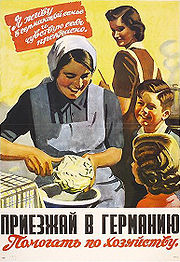
Originally, this recruitment was carried out only in the annexed territories of Poland, but the lack of women who passed screening extended it to all of Poland, and also to occupied territories in USSR.
On September 3, 1942, Hitler demanded that half a million Ukrainian women be brought to Germany to free German women from housekeeping. These women were recruited in consequence of Hitler's belief that there was a Germanic strain in Ukraine because the Ostrogoths and Visigoths had lived in southern Ukraine 1,800 years earlier and the "chaste peasant virtues of Ukrainian women" appealed to him. Only about 15,000 girls were taken to Germany to work as domestics.
Conditions
In Germany OST-Arbeiters lived in both private camps owned and managed by the large companies, and special camps guarded by privately paid police services known as the Werkschutz.They worked an average of 12 hours a day, six days a week.
The pay was approximately 30% a German worker's wages; however, most of the money went toward food, clothing and board. The labor authorities complained that many firms viewed these former Soviet civilian workers as "civilian prisoners", treated them accordingly, and paid no wages at all to them. Those that were paid were paid with specially printed paper money and savings stamp
Savings stamp
A Savings Stamp is a stamp issued by a government or other body to enable small amounts of money to be saved over time to accumulate a larger capital sum. The funds accumulated may then be used to make a larger purchase such as taking out a savings bond or to pay a large upcoming bill...
s, which could only be used toward the purchase of a limited number of items in special camp stores. By law, they were given worse food rations than other forced labor groups. Starvation rations and primitive accommodation were given to these unfortunates in Germany.
OST-Arbeiters were forced to wear a badge OST (East) on their clothes at all times.
The Ostarbeiters were restricted to their place of residence (in some cases labor camps) and forbidden to fraternize with Germans. They were regarded as subhuman, and were ordered to be kept separated from the German population. The Germans considered the Ukrainians Untermensch
Untermensch
Untermensch is a term that became infamous when the Nazi racial ideology used it to describe "inferior people", especially "the masses from the East," that is Jews, Gypsies, Poles along with other Slavic people like the Russians, Serbs, Belarussians and Ukrainians...
(sub-humans) "inferior humans" who could be kicked, beaten, terrorized and killed at their least transgression. Those who tried to escape were hanged where other workers could see their bodies. Leave without authorization or escape was punished by death. All sexual relations, even those that did not result in pregnancy, were severely punished as Rassenschande
Rassenschande
Rassenschande or Blutschande was the Nazi term for sexual relations between Aryans and non-Aryans, which was punishable by law...
or racial pollution.
Many died when the factories where they were employed were bombed during Allied bombing raids. Many also perished because the German authorities ordered that "they should be worked to death".
Nazi authorities attempted to reproduce such conditions on the farm, where farmers were ordered to integrate the Eastern workers into their workforce while enforcing total social separation, including not permitting them to eat at the same table, but this proved far more difficult to enforce. Sexual relationships in particular were able to take place despite efforts to raise German women's "racial consciousness". When the war condition worsened, these workers' conditions often improved as the farmers tried to protect themselves against a defeat.
Few were able to get released and return to Ukraine to tell their story. Cases are known where girls had chopped off their fingers in a machine in order to get back home.
Statistics
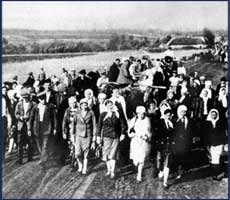
Between two-thirds and three-quarters of the over 3,000,000 Ostarbeiter were Ukrainians. Prof. Kondufor's statistic is that 2,244,000 Ukrainians were forced into slave labor in Germany during World War II. Another statistic puts the total at 2,196,166 for Ukrainian Ostarbeiter slaves in Germany (Dallin, p. 452).
Both of these statistics probably do not include the several hundreds of thousands of Ukrainians from Halychyna, so a final total could be about 2.5 million.
Work and employment
There were slightly more women than men Ostarbeiters. They were employed in agriculture, mining, manufacturing armaments, metal production and railroads.OST-Arbeiters were initially sent to intermediate camps, where laborers were picked out for their assignments directly by representatives of labor-starved companies. Ford-Werke in Cologne
Cologne
Cologne is Germany's fourth-largest city , and is the largest city both in the Germany Federal State of North Rhine-Westphalia and within the Rhine-Ruhr Metropolitan Area, one of the major European metropolitan areas with more than ten million inhabitants.Cologne is located on both sides of the...
and Opel
Opel
Adam Opel AG, generally shortened to Opel, is a German automobile company founded by Adam Opel in 1862. Opel has been building automobiles since 1899, and became an Aktiengesellschaft in 1929...
in Russelsheim
Rüsselsheim
Rüsselsheim is the largest town in the Groß-Gerau district in the Rhein-Main region of Germany. It is one of seven special status towns in Hesse and is located on the Main, only a few kilometres from its mouth in Mainz. The suburbs of Bauschheim and Königstädten are included in Rüsselsheim...
and Brandenburg
Brandenburg
Brandenburg is one of the sixteen federal-states of Germany. It lies in the east of the country and is one of the new federal states that were re-created in 1990 upon the reunification of the former West Germany and East Germany. The capital is Potsdam...
each employed thousands of such "Ostarbeiter" at their plants.
Some OST-Arbeiters worked for private firms although many were employed in the factories making armaments. These factories were prime targets for Allied bombing. The OST-Arbeiters were considered to be quite productive and efficient. Males were thought to be the equivalent of 60-80 % of a German worker, and women — 90-100%.
Two million Ukrainians worked mostly in the armaments factories including the V-2 rocket factory at Peenemünde
Peenemünde
The Peenemünde Army Research Center was founded in 1937 as one of five military proving grounds under the Army Weapons Office ....
.
Pregnancy
To prevent violations of German racial lawsRassenschande
Rassenschande or Blutschande was the Nazi term for sexual relations between Aryans and non-Aryans, which was punishable by law...
, the workers were to be recruited in equal numbers of men and women, so brothels would not be needed, but women who became pregnant were less effective workers. The original policy, sending them home, created an incentive for women to become pregnant. As a consequence, contrary to the usual Nazi law against abortions, they could be aborted, even against their will.
However, if the woman and the baby's father were "of good blood", the child might likewise prove "racially valuable." Consequently, the parentage was investigated, and both parents tested. If they passed, the woman would be permitted to give birth, and the child removed for Germanization. If the woman was found particularly suitable, she might be removed to a Lebensborn
Lebensborn
Lebensborn was a Nazi programme set up by SS leader Heinrich Himmler that provided maternity homes and financial assistance to the wives of SS members and to unmarried mothers, and also ran orphanages and relocation programmes for children.Initially set up in Germany in 1935, Lebensborn expanded...
institution. If the born children did not pass, they would be removed to an Ausländerkinder-Pflegestätte
Ausländerkinder-Pflegestätte
Ausländerkinder-Pflegestätte , also Säuglingsheim, Entbindungsheim, were Third Reich institutions where babies and children, abducted from Eastern European forced laborers from 1943 to 1945, were kept.-Nazi policy:...
, where many died to the lack of food.
This was more difficult to enforce in rural areas, and authorities found that German farm wives cared for such children born to their workers alongside their own children. Attempts even there were made to segregate the children and use ruthless propaganda to establish that if a worker of "alien blood" gave birth in Germany, it meant immediate and total separation from the child.
Repeated efforts were made to propagate Volksturm, racial consciousness, to prevent sexual relations between Germans and foreign workers
Rassenschande
Rassenschande or Blutschande was the Nazi term for sexual relations between Aryans and non-Aryans, which was punishable by law...
.
OST-Arbeiters and medical experiments
On September 6, 1944 the Reichsminister of the Interior ordered the establishment of special units for "Ostarbeiter" in several psychiatric hospitals in the Reich. The reason given was that: "With the considerable number of "Ostarbeiter" who have been brought to the German Reich as a labour force, their admission into German psychiatric hospitals as mentally ill patients has become more frequent ...With the shortage of space in German hospitals, it is irresponsible to treat these ill people, who in the foreseeable future will not be fit for work, for a prolonged period in German institutions."
The exact number of "Ostarbeiter" killed in these psychiatric institutions is as yet not known.
189 "Ostarbeiter" were admitted to the "Ostarbeiter" unit of the Heil- und Pflegeanstalt Kaufbeuren; 49 died as a result of the starvation diet, or from deadly injections.
Repatriation
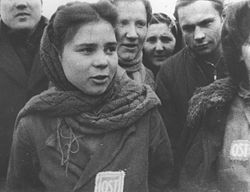
Kempten
Kempten can refer to:* Kempten im Allgäu, a town in Bavaria, Germany* Kempten ZH, a district of the town of Wetzikon in the canton of Zurich, Switzerland* Kempton Park, Gauteng, a city in South Africa which was named after Kempten in Bavaria...
for processing and returned to their country of origin, primarily to the USSR. The Soviets also used special Agit
Agitprop
Agitprop is derived from agitation and propaganda, and describes stage plays, pamphlets, motion pictures and other art forms with an explicitly political message....
brigades to convince many OST-Arbeiters to return.
Many OST-Arbeiters were still children or young teenagers when they were taken away and wanted to return home to their parents. Others who became aware of or understood the postwar political reality declined to return. Those in the Soviet occupational zones were returned automatically. Those in the French and English zones of occupation were forced to return under the terms of the Yalta Agreement, which stated that "Citizens of the Soviet Union and of Yugoslavia were to be handed over to their respective countries, regardless of their consent".
In October 1945 General Eisenhower banned the use of force in repatriation in the American Zone. As a result, many OST-Arbeiters began to escape to the American Zone. Some, when faced with return to Soviet reality, chose to commit suicide.
On return to the Soviet Union OST-Arbeiters were often treated as traitors. Many were transported to remote locations in the Soviet Union and were denied basic rights and the chance to get further education. Nearly 80 percent of [Russian workers and prisoners of war returning from Germany] were sent to forced labour, some given fifteen to twenty-five years of 'corrective labour', others sent off to hard labour; all were categorized as 'socially dangerous'.
Those who returned home were also physically and spiritually broken; moreover, they were considered by the authorities as having "questionable loyalty", and were therefore discriminated against and deprived of many of their citizenship rights.
OST-Arbeiters suffered from state-sanctioned stigmatisation, with special references in their passports (and the passports of children and relatives) mentioning their time in Germany during the war. As a result many jobs were off-limits to anyone unlucky enough to carry such a status, and during periods of repression former slave labourers would often be ostracised by the wider Soviet community. Many victims have testified that since the war they have suffered a lifetime of abuse and suspicion from their fellow countrymen, many of whom have accused them of being traitors who helped the Germans and lived comfortably in the Third Reich while Ukraine burned.
When applying for jobs, travel abroad or for certain other, politically sensitive activities which needed sanction by the Party authorities or the KGB, people had to fill out questionnaires (ankety). If a person was deemed to be of the "wrong" nationality or "past", their chances of travel or work (and certain areas of study) were restricted
In extreme cases, some workers, when returned to the Soviet Union after the war, were incarcerated in Gulags and some were executed as collaborators.
Pensions and retribution
In 2000 the Foundation "Remembrance, Responsibility and Future"Foundation "Remembrance, Responsibility and Future"
The Foundation "Remembrance, Responsibility and Future" , is a German Federal organisation with the purpose of making financial compensation available "to former forced laborers and to those affected by other injustices from the National Socialist period"...
, a project of the German Federal Government and 6,500 companies of the German Industry Foundation Initiative, was established, which disbursed 10 billion Deutsche Mark (5.1 billion €) to the former forced laborers. This is roughly € 2,000 per worker, much less than the inflation-adjusted value of their work. Of the over 2 million OST-Arbeiters in Ukraine, 467,000 received a total amount of € 867 million, with each worker being assigned a one-time payment of 4,300 marks. Much of this money however did not make it to its proper destination and the OST-Arbeiters were once again cheated.484,000 recipients in Poland received € 979 million.
The last payments were made in 2007.
Research
Published eyewitness accounts of the Ukrainian Ostarbeiter experience are virtually non-existent in Ukraine although there were 2,244,000 of them from Ukraine according to historian Yuri Kondufor. A total of 3,000,000 Ostarbeiters were taken to Germany and it is estimated that Ukrainians constituted about 75% of the total. Ukraine, according to some sources, lost about 10 million people in World War II, which was one of the greatest losses of any country in the war.Some Ostarbeiters survived the war and emigrated to the West, primarily to the United States, although a handful also made it to Australia, Canada and Brazil. Ostarbeiters who found themselves in the British or French zones were automatically repatriated. Only those who were in the American zone were not forced to return back to their countries of origin. In comparison Ukrainians from Western Ukraine and the Baltic region were not forced to return to the Soviet Union because the UK did not recognize those territories as part of the USSR.
In 1998 only two Ostarbeiters had been located in Canada for interviews for the audio and video archives of the Ukrainian Canadian Research & Documentation Centre in Toronto.
Recently a film was made by Ukrainian television focusing on the plight of the Ukrainian Ostarbeiters who returned to the Soviet Union, demonstrating the harsh and inhumane treatment that they continued to receive after their repatriation.
Culture
Ukrainian-Canadian poet Yar Slavutych wrote an epic dumaDuma
A Duma is any of various representative assemblies in modern Russia and Russian history. The State Duma in the Russian Empire and Russian Federation corresponds to the lower house of the parliament. Simply it is a form of Russian governmental institution, that was formed during the reign of the...
about Kempten
Kempten im Allgäu
Kempten is the largest town in Allgäu, a region in the south-west of Bavaria, Germany. The population was ca 61,000 in 2006. The area was possibly settled originally by Celts, but was later overtaken by the Romans, who called the town Cambodunum...
, the camp from which Ukrainian OST-Arbeiters were processed for repatriated to the Soviet Union. The poem was set to music by Hryhory Kytasty
Hryhory Kytasty
Hryhoriy Trokhymovych Kytasty was a Ukrainian émigré composer and conductor. In 2008 he was honored with the Hero of Ukraine state decoration.- Early years :Hryhory Kytasty was born in the town of Kobeliaky, Poltava oblast...
for soloist, male chorus and symphony orchestra accompaniment. It was first performed in Washington in 1959.
See also
- Deutsche WirtschaftsbetriebeDeutsche WirtschaftsbetriebeDeutsche Wirtschaftsbetriebe , generally abbreviated DWB was a project launched by the Allgemeine SS to profit from the use of Nazi concentration camp inmates as slave labor.- Holding company for Nazi concerns :...
- Generalplan OstGeneralplan OstGeneralplan Ost was a secret Nazi German plan for the colonization of Eastern Europe. Implementing it would have necessitated genocide and ethnic cleansing to be undertaken in the Eastern European territories occupied by Germany during World War II...
and the Hunger PlanHunger PlanThe Hunger Plan was an economic management scheme that was put in place to ensure that Germans were given priority over food supplies, at the expense of everyone else. This plan was featured as part of the planning phase of the Wehrmacht invasion of the Soviet Union in 1941...
: other aspects of Nazi plans to use and abuse eastern Europe - HiwiHiwi (volunteer)Hiwi is a German abbreviation. It has two meanings, "voluntary assistant" and "assistant scientist" .- :...
- Nazi crimes against Soviet POWsNazi crimes against Soviet POWsThe Nazi crimes against Soviet Prisoners of War relate to the deliberately genocidal policies taken towards the captured soldiers of the Soviet Union by Nazi Germany...
- UntermenschUntermenschUntermensch is a term that became infamous when the Nazi racial ideology used it to describe "inferior people", especially "the masses from the East," that is Jews, Gypsies, Poles along with other Slavic people like the Russians, Serbs, Belarussians and Ukrainians...
- Kidnapping of Polish children by Nazi GermanyKidnapping of Polish children by Nazi GermanyKidnapping of Eastern European children by Nazi Germany , part of the Generalplan Ost , involved taking children from Eastern Europe and moving them to Nazi Germany for the purpose of Germanization, or conversion into Germans....
- Victims of YaltaVictims of YaltaVictims of Yalta is the British and The Secret Betrayal the American title of a 1977 book by Nikolai Tolstoy that chronicles the fate of Soviet people who had been under German control during World War II and at its end fallen into the hands of the Western Allies...
- ZivilarbeiterZivilarbeiterZivilarbeiter refers primarily to Polish prisoners from the General Government , used during WWII as forced laborers in Germany. Poles were conscripted on the basis of the Polish decrees ....
- Heu-AktionHeu-AktionHeu-Aktion was the name of an Nazi German operation where 40,000 to 50,000 Polish, Belarusian and Ukrainian children aged 10 to 14 were kidnapped by the German military and transported to Germany as slave labourers. The term "heu-aktion" means "collective harvesting of hay". After arriving in...
- Girl No. 217Girl No. 217Girl No. 217 is a 1945 Soviet drama film directed by Mikhail Romm. It was entered into the 1946 Cannes Film Festival.An anti-Nazi film, it depicted a Russian girl enslaved to an inhuman German family. She is even robbed of her name and forced to answer to "No. 217". Subplots depict abuse...
Sources
- Ukrainian - The Third road for Germans Catholics
- dokumentartheater berlin and their production "OST-Arbeiter"
- Andrew Gregorovich - World War II in Ukraine
- An Ostarbeiter's Employment Identification Document
- Reinhold Billstein (Editor) Working for the Enemy: Ford, General Motors, and Forced Labor in Germany During the Second World War - Berghahn Books (November 2000) ISBN 1571812245
Ukrainian
External links
- Europe at Work in Germany propaganda aimed at Germans about the program

